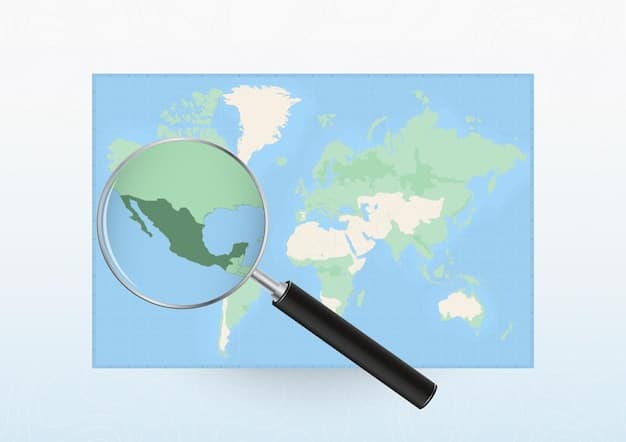Mexico’s Security Situation: Latest Travel Advisories for US Citizens

Navigating the complexities of travel to Mexico requires a thorough understanding of its evolving security landscape; the U.S. State Department regularly updates its travel advisories, providing crucial insights for American citizens to make informed decisions about their safety abroad.
Considering a trip to our vibrant southern neighbor? Understanding Mexico’s Security Situation: What Are the Latest Travel Advisories for US Citizens? is vital for planning a safe and enjoyable journey. The dynamic nature of global travel necessitates an informed approach, especially when venturing into new territories. This article aims to distill the most recent information, offering clarity amidst often complex geopolitical narratives.
Understanding the Layers of Mexico’s Security Landscape
Mexico, a country of immense cultural richness and diverse landscapes, attracts millions of international visitors annually. However, like any nation, it faces its share of challenges, including security concerns that can vary significantly from one region to another. For United States citizens considering travel to Mexico, grasping the nuances of its security landscape is paramount. It’s not a monolithic situation; rather, it’s a mosaic of regional conditions, local dynamics, and evolving risk factors.
The perception of security in Mexico is often shaped by media reports, which tend to focus on instances of violence, sometimes painting an overly broad picture. While certain areas do experience heightened levels of crime and instability, many popular tourist destinations remain relatively safe and welcome millions of visitors without incident. The key lies in understanding where these risks are concentrated and how official travel advisories can guide decision-making. The U.S. State Department’s advisories are designed to provide a comprehensive, albeit cautious, overview.
Distinguishing Between General Safety and Specific Threats
When assessing Mexico’s security, it’s crucial to differentiate between general safety precautions applicable to any international travel—such as awareness of petty crime and scams—and specific threats posed by organized criminal activity. The latter often disproportionately affects local populations and specific industries, though it can occasionally impact tourists who venture into high-risk areas or engage in risky behaviors. Understanding this distinction helps in appreciating the context of travel warnings.
- Crime Variances: Petty crime, including pickpocketing and bag snatching, is common in crowded tourist areas and major cities, much like in many global destinations.
- Organized Crime: Activities linked to organized crime, such as kidnappings, extortion, and inter-gang violence, are more prevalent in certain states and border regions.
- Tourist Targets: While rare, tourists can become targets, either incidentally or through involvement in illicit activities or by being in the wrong place at the wrong time.
Beyond the direct threat of violence, other considerations include civil unrest, natural disasters, and health concerns, all of which contribute to the overall security assessment. These factors, though not always directly crime-related, are integrated into official travel guidance to provide a holistic view for travelers.
The Role of Local Context and Personal Responsibility
Ultimately, a significant part of managing travel risk in Mexico involves personal responsibility and situational awareness. Relying solely on broad generalizations can be misleading. Instead, travelers should delve into the specifics of their intended destinations, including the most recent local news, advice from local authorities, and experiences shared by other travelers. The security situation in Baja California Sur, for instance, may differ vastly from that in Guerrero or Jalisco.
Additionally, understanding that even within a state, security can vary from city to city, or even neighborhood to neighborhood, is vital. Major tourist zones often have enhanced security measures and infrastructure compared to more remote or less frequented areas. Engaging with tour operators, reputable hotels, and local contacts can also provide invaluable on-the-ground intelligence that supplements official advisories.
In summary, approaching Mexico’s security situation requires a layered understanding, moving beyond headlines to examine regional differences, specific threats, and the importance of personal vigilance. This comprehensive perspective forms the foundation for making well-informed travel choices.
Decoding the U.S. State Department’s Travel Advisories
For US citizens, the U.S. State Department’s travel advisories serve as the primary official source of information regarding international travel safety. These advisories are not static; they are regularly updated to reflect ongoing geopolitical, social, and security developments in countries around the world. Understanding how to interpret these advisories is crucial, as they provide a structured framework for assessing risk. They operate on a four-level system, each indicating a different degree of caution.
The Four Advisory Levels Explained
The State Department’s system is designed to convey risk in a clear, graduated manner. Each level comes with specific recommendations and implications for travelers:
- Level 1: Exercise Normal Precautions – This is the lowest advisory level for safety and security risk. This means the overall risk of travel to this location is typical for international travel.
- Level 2: Exercise Increased Caution – Travelers should be aware of heightened risks to safety and security. While travel can still occur, it’s advised to be more vigilant. Specific reasons for this level, like increased crime or civil unrest, are usually detailed.
- Level 3: Reconsider Travel – This level indicates serious risks to safety and security. The State Department advises citizens to reconsider travel and, if they do go, to be prepared for potential dangers. Reasons can include high crime rates, terrorism, or widespread civil unrest.
- Level 4: Do Not Travel – This is the highest advisory level, indicating a high likelihood of life-threatening risks. The State Department advises against all travel to this location. Reasons could include active armed conflict, natural disaster aftermath, or extreme levels of crime.
It is important to note that these advisories are broad and often apply to an entire country, although specific regions or states within a country might have different, more granular advisory levels. This nuance is particularly relevant for a large and diverse country like Mexico, where security conditions can vary dramatically from one state to another.
Mexico’s Specific Advisory Landscape
Mexico rarely has a blanket Level 1 or Level 4 advisory for the entire country. Instead, the U.S. State Department typically issues varied advisories for individual Mexican states, reflecting the diverse security situations within the nation. For example, popular tourist spots like Cancún in Quintana Roo or Puerto Vallarta in Jalisco might be under a Level 2 “Exercise Increased Caution” advisory, while certain states like Colima or Guerrero might be under a Level 4 “Do Not Travel” advisory due to high rates of organized crime and violence.
This state-by-state assessment is critical for US citizens planning a trip. It means that while one area may be relatively safe for tourism, a neighboring state could pose significant risks. Travelers should consult the advisory for their specific destination within Mexico, rather than relying on a general impression of the country’s overall security.

Beyond the Levels: What Else to Look For
Beyond the numerical level, the State Department advisories provide detailed explanations for their determinations. These narratives offer invaluable context, outlining the specific types of risks present, whether it be street crime, carjackings, kidnappings, or gang violence. They also often include practical advice, such as avoiding certain areas, exercising caution at night, or enrolling in the Smart Traveler Enrollment Program (STEP).
Travelers are encouraged not just to note the level but to read the entire advisory document for their destination. This comprehensive approach ensures a full understanding of the potential challenges and recommended precautions, empowering travelers to make truly informed decisions about their safety abroad. By understanding and utilizing these advisories, US citizens can navigate Mexico’s security situation with greater confidence and preparedness.
Specific States and Their Current Travel Advisory Levels
Mexico’s vast geography and varying local dynamics mean that its security situation is far from uniform. The U.S. State Department’s travel advisories reflect this diversity by typically assigning different levels of risk to individual Mexican states. For US citizens planning travel, a granular understanding of these state-specific advisories is indispensable, moving beyond general perceptions to precise, actionable information about their intended destination.
The advisories categorize states into various risk levels, from those recommending normal precautions to those advising against all travel. This section provides a snapshot of the types of advisories typically seen for different states, highlighting the spectrum of security conditions cross Mexico.
States Under “Do Not Travel” Advisories (Level 4)
Certain Mexican states frequently appear on the “Do Not Travel” list due to very high levels of crime and violence. These are often areas where organized crime is highly active, leading to dangerous conditions for both residents and visitors. While advisories can change, historically, states like:
- Colima: Cited for high rates of violent crime and organized criminal activity.
- Guerrero (excluding specific tourist areas like Ixtapa/Zihuatanejo): Often flagged for severe violence, including turf battles between criminal organizations.
- Michoacán (excluding specific tourist areas): Known for significant levels of organized crime and violence.
- Sinaloa (excluding specific tourist areas like Mazatlán): A historically difficult state due to the presence of large criminal organizations.
- Tamaulipas: Particularly along the U.S. border, known for high rates of crime, including kidnappings and carjacking.
For these states, the U.S. State Department’s recommendation is unequivocal: avoid all travel. The risks in these areas are deemed to be life-threatening, making any visit highly perilous.
States Under “Reconsider Travel” Advisories (Level 3)
A number of states fall under the “Reconsider Travel” category, indicating serious risks that warrant careful consideration before visiting. These areas may not have the same immediate or widespread life-threatening dangers as Level 4 states, but they still present significant security concerns. Examples often include:
- Baja California: While Tijuana and Rosarito are popular, parts of the state have high crime rates.
- Jalisco (excluding Puerto Vallarta): Despite Puerto Vallarta being a major tourist hub, other parts of the state, including Guadalajara, can experience significant crime.
- Mexico State: Surrounding Mexico City, parts of this state have elevated crime levels.
- Zacatecas: Has seen increased violence in recent years due to organized crime.
Travelers to these states are advised to exercise extreme caution, remain vigilant, and be prepared for potential dangers. It’s often recommended to avoid non-essential travel and to stick to well-trafficked tourist areas if visiting.
States Under “Exercise Increased Caution” Advisories (Level 2)
Many popular tourist destinations and larger, more stable states fall under “Exercise Increased Caution.” This level acknowledges some risk but suggests that with increased vigilance, travel is generally safe. This category often includes:
- Quintana Roo (Cancún, Playa del Carmen, Tulum): While immensely popular, there have been isolated incidents of violence, often related to organized crime, that have impacted tourist areas. Tourists are advised to be aware of their surroundings, especially at night.
- Yucatan State (Merida): Generally considered one of Mexico’s safest states, it still advises increased caution due to typical precautions needed when traveling abroad.
- Mexico City (CDMX): As a major metropolitan area, it is subject to the usual urban risks like petty crime and occasional protests, warranting increased caution.
For these areas, US citizens are encouraged to take standard precautions, such as safeguarding valuables, avoiding isolated areas, and being aware of their surroundings. This is comparable to the level of caution one might exercise in any large city or popular tourist destination globally.
It’s crucial for travelers to check the very latest advisories on the State Department’s website immediately before departure, as conditions can change rapidly. This tailored approach allows for a more nuanced and realistic assessment of risk, empowering travelers to make informed decisions for their specific journeys.
Safety Tips for U.S. Citizens Traveling to Mexico
Even with the most up-to-date travel advisories, personal safety remains largely in the hands of the traveler. While Mexico offers incredible experiences, practicing smart travel habits is essential, regardless of the destination’s current advisory level. For US citizens, adopting a proactive and informed approach to personal security can significantly mitigate risks and enhance the overall travel experience.
These tips encompass a range of precautions, from pre-trip planning to on-the-ground behavior, all designed to increase awareness and minimize vulnerability to common travel hazards. They are general guidelines that apply broadly but should be adapted to the specific context of your chosen destination within Mexico.
Pre-Trip Planning and Preparation
The foundation of a safe trip begins long before you board the plane. Thorough preparation can prevent many common travel dilemmas and equip you to handle unexpected situations:
- Enroll in STEP: The Smart Traveler Enrollment Program (STEP) is a free service that allows U.S. citizens and nationals traveling and living abroad to enroll their trip with the nearest U.S. Embassy or Consulate. It enables them to receive important information from the Embassy about safety conditions in their destination country and helps the U.S. Embassy contact them in an emergency.
- Research Your Destination: Go beyond just checking the State Department advisory. Research specific neighborhoods, common local scams, and transportation options. Read reviews of hotels and tour operators.
- Secure Documents: Make photocopies or digital copies of your passport, visa, and other important documents. Leave actual copies with a trusted person at home. Store digital copies in a secure cloud service.
- Travel Insurance: Consider comprehensive travel insurance that covers emergency medical treatment, medical evacuation, and trip interruption.
- Inform Your Bank: Notify your bank and credit card companies of your travel plans to prevent holds on your accounts due to unusual international activity.
Having these elements in place provides a safety net and keeps you connected to consular services if needed.
On-the-Ground Awareness and Behavior
Once in Mexico, your behavior and awareness directly impact your safety. Adopting a vigilant yet relaxed demeanor is key:
- Be Aware of Your Surroundings: Pay attention to people around you and your environment. Trust your instincts; if a situation feels off, remove yourself.
- Protect Valuables: Avoid displaying expensive jewelry, electronics, or large sums of cash. Use anti-theft bags or money belts. Be cautious when using ATMs.
- Transportation Safety: Use only authorized and reputable taxis or ride-sharing services. Avoid hailing cabs off the street, especially at night. If renting a car, understand local driving laws and avoid driving at night, especially in less familiar areas.
- Limit Alcohol Consumption: Excessive alcohol consumption can impair judgment and make you a more vulnerable target. Be wary of spiked drinks.
- Nightlife Caution: Be cautious in bars and nightclubs. Do not walk alone at night, particularly in unlit or unfamiliar areas.
- Local Laws and Customs: Respect local laws and cultural norms. Ignorance of the law is no excuse.
By integrating these safety tips into your travel habits, you can significantly enhance your security profile and enjoy the beauty and hospitality of Mexico with greater peace of mind. Personal responsibility, coupled with official guidance, forms the cornerstone of safe international travel.
Assessing the Impact of Drug-Related Violence on Tourists
The pervasive issue of drug-related violence in Mexico often dominates international headlines, understandably raising concerns among potential tourists. While this violence is a grave reality for many Mexican communities, its direct impact on foreign tourists is often misunderstood and can be disproportionately represented. It’s crucial for US citizens to understand the nature of this violence and assess its true risk to their travel plans.
Drug-related violence largely stems from conflicts between organized criminal groups vying for control over trafficking routes and illicit markets. These confrontations typically involve specific individuals and territories, and tourists are generally not primary targets. However, the geographic spread and intensity of these conflicts can create indirect risks, particularly in areas where criminal elements are active or where tourists inadvertently cross paths with such operations.
The Nature of Drug-Related Violence
Most drug-related violence in Mexico does not directly target tourists. Instead, it typically involves:
- Turf Wars: Conflicts between rival cartels over drug production, transportation, and distribution routes.
- Extortion and Intimidation: Targeting local businesses and residents, sometimes leading to violent confrontations.
- Internal Purges: Violence within criminal organizations.
While these activities are primarily internal to criminal operations, the sheer scale of the violence can sometimes lead to collateral damage. Incidents such as shootouts in public places, even if not aimed at tourists, can create dangerous situations for anyone nearby. This is why official advisories often highlight areas where such activity is prevalent as “Do Not Travel” or “Reconsider Travel” zones.
Popular tourist destinations, particularly those with strong law enforcement presence and significant economic reliance on tourism, generally experience lower rates of drug-related violence impacting visitors. However, even in these areas, isolated incidents can occur, often linked to the drug trade that caters to tourist demand.
Indirect Impacts and Collateral Risk
The primary way drug-related violence can affect tourists is through indirect exposure or being in the wrong place at the wrong time. This could involve:
- Unintentional Proximity: Being near a conflict zone or a location targeted by criminal activity.
- Targeted for Involvement: Although rare, tourists who engage in illicit activities, such as purchasing illegal drugs, significantly increase their risk of becoming involved in or targeted by criminal elements.
- Vehicle Checkpoints and Roadblocks: In some areas, criminal groups may set up unofficial checkpoints or roadblocks, which can be dangerous.
The U.S. State Department’s advisories often delineate specific areas where these risks are higher, advising against travel to those regions. For instance, while certain coastal towns in a state might be deemed safer, inland areas or border regions within the same state could be highly dangerous due to drug cartel activity.
To mitigate these risks, tourists should always adhere to official advisories, stick to well-known and reputable tourist areas, and avoid any involvement in illicit drug activities. Staying informed about local news and emergency services contact information is also a prudent measure. By understanding the true nature of drug-related violence and its limited, though notable, impact on tourism, travelers can make more rational decisions about their safety in Mexico.
Other Considerations: Health, Natural Disasters, and Local Regulations
While security concerns often dominate the discussion for US citizens traveling to Mexico, a comprehensive travel plan should also account for other crucial factors: health, potential natural disasters, and local regulations. These elements contribute significantly to the overall safety and comfort of a trip, and being unprepared can lead to substantial disruptions or risks.
Addressing these aspects requires proactive research and planning, ensuring that travelers are equipped to handle various situations that extend beyond traditional crime statistics. From understanding local healthcare provisions to being aware of environmental risks, a holistic approach to travel preparedness is essential for a smooth and enjoyable experience.
Health and Medical Preparedness
Access to quality healthcare and understanding potential health risks is paramount when traveling internationally. Mexico offers varying standards of medical care, with private facilities in major cities often providing services comparable to those in the U.S., but at a cost. Public healthcare facilities, especially in rural areas, may be more limited.
- Traveler’s Diarrhea: This is a common ailment. Drink only bottled water, avoid ice in drinks (unless assured it’s made from purified water), and be cautious with raw fruits and vegetables not peeled by you.
- Mosquito-borne Illnesses: Dengue, Zika, and Chikungunya are present in certain regions. Use insect repellent, wear protective clothing, and sleep under mosquito nets if necessary.
- Prescription Medications: Carry an adequate supply of any necessary prescription medications, along with a copy of the prescription and a doctor’s note, to avoid issues at customs.
- Medical Insurance: Ensure your health insurance covers international travel and repatriation. Consider purchasing supplemental travel medical insurance, as U.S. Medicare/Medicaid does not cover overseas medical expenses.
Familiarize yourself with the location of hospitals and pharmacies near your accommodation. Having a plan for medical emergencies can significantly reduce stress and improve outcomes.
Natural Disasters and Environmental Risks
Mexico is geographically diverse and prone to several natural phenomena, including earthquakes, hurricanes, and volcanic activity. Awareness of these risks and how to respond is vital.
- Earthquakes: Mexico is in an active seismic zone. Familiarize yourself with earthquake safety procedures, especially if staying in tall buildings.
- Hurricanes: The hurricane season typically runs from June to November, affecting both the Pacific and Atlantic coasts. Monitor weather forecasts, especially if traveling during these months, and be prepared for potential evacuations or disruptions.
- Volcanic Activity: Mexico has active volcanoes. While major eruptions are rare, ashfall and associated health issues can occur in nearby areas. Stay informed about any volcanic advisories from local authorities.
- Extreme Heat: In many parts of Mexico, especially during summer, temperatures can be extremely high. Stay hydrated, seek shade, and avoid prolonged exposure to direct sun.
The U.S. Embassey and Consulates often issue alerts for natural disasters, so staying enrolled in STEP is beneficial for receiving real-time updates.
Local Regulations and Cultural Nuances
Understanding and respecting local laws and customs can prevent misunderstandings and legal issues. What might be acceptable in the U.S. may not be so in Mexico.
- Drug Laws: Mexico has very strict drug laws. Penalties for possession, use, or trafficking of illegal drugs are severe, even for small amounts.
- Alcohol Consumption: Public consumption of alcohol is generally prohibited outside of licensed establishments. Be aware of local open container laws.
- Firearms: Mexican law strictly prohibits the possession of firearms, even if you have a permit to carry one in the U.S. Violations can lead to severe penalties.
- Cultural Sensitivities: Be respectful of local customs, especially in religious sites. Dress modestly when visiting churches or traditional communities. Learn basic Spanish phrases; it’s appreciated and can be very helpful.
Being mindful of these broader considerations, alongside security advisories, ensures a more responsible, safer, and ultimately more rewarding travel experience in Mexico. It highlights that true preparedness encompasses more than just crime awareness; it’s about holistic readiness for an international environment.
Future Outlook and How Advisories Are Formed
The security situation in Mexico, and consequently the U.S. travel advisories, is not static; it is a dynamic landscape that evolves based on a complex interplay of factors. Understanding how these advisories are formed, and the ongoing efforts to keep them relevant, provides US citizens with insight into the continuous assessment processes by the U.S. State Department. This transparency helps travelers appreciate the depth of information that goes into guiding their safety abroad.
The future outlook for security in Mexico remains multifaceted. While there are ongoing challenges, particularly related to organized crime, there are also dedicated efforts by Mexican authorities and international cooperation programs to address these issues. The advisories reflect this evolving reality, aiming to provide the most current and accurate picture possible.
The Advisory Formulation Process
The U.S. State Department’s travel advisories are the product of rigorous analysis, drawing on a wide array of sources. This comprehensive approach ensures that the advice offered is as informed and timely as possible:
- Intelligence Gathering: Information is continually collected from U.S. embassies and consulates on the ground in Mexico, local law enforcement contacts, and various intelligence agencies. This includes data on crime rates, political stability, and natural disaster threats.
- Public Information: Open-source intelligence, including local news reports, academic studies, and credible non-governmental organization (NGO) reports, is also monitored and analyzed.
- Regular Reviews: Advisories are not just issued once; they are regularly reviewed and updated. This can be on a pre-scheduled basis or in response to significant events, ensuring that the information remains current.
- Interagency Coordination: The Department of State often consults with other U.S. government agencies, such as the Department of Homeland Security and intelligence communities, to ensure a holistic assessment of threats.
This multi-layered approach means that the travel advisories are arguably the most authoritative and comprehensive guidance available to US citizens regarding their safety in Mexico. They represent an accumulation of expertise and real-time data.
Factors Influencing Future Advisories
Several key factors will continue to influence future travel advisories for Mexico:
- Organized Crime Dynamics: Shifts in cartel power, new trafficking routes, or changes in law enforcement strategies can alter the security landscape.
- Economic Conditions: Economic stability or instability can sometimes correlate with shifts in crime rates and social unrest.
- Government Policies: Actions taken by the Mexican government regarding security, law enforcement, and social programs will have a direct bearing on the overall situation.
- Migration Patterns: Changes in migration flows, particularly along border regions, can also impact security concerns.
- Public Health Events and Natural Disasters: Future outbreaks of diseases or major natural disasters will continue to trigger specific advisories or adjustments to existing ones.
Given these complexities, it’s virtually impossible to predict a definitive “future outlook” for Mexico’s security. What is certain is that the nature of security challenges will continue to evolve. For travelers, this underscores the importance of not relying on outdated information and consistently checking the latest advisories.
The dynamic nature of security underscores the State Department’s methodology. Rather than offering static pronouncements, the advisories are living documents, continuously refined to reflect the most current realities. For US citizens, engaging with these resources proactively is the most effective way to navigate travel to Mexico safely and responsibly, empowering informed decisions rooted in expert analysis rather than hearsay or outdated assumptions.
| Key Point | Brief Description |
|---|---|
| 📊 Advisory Levels Vary | The U.S. State Department uses a four-level system for Mexico, often with state-specific designations. |
| ⚠️ Read Detailed Advisories | Beyond the level, understand specific risks and recommended precautions for your destination. |
| 🛂 Enroll in STEP | Smart Traveler Enrollment Program (STEP) helps the Embassy assist you in emergencies. |
| 🩺 Beyond Crime | Consider health, natural disasters, and local laws for a comprehensive safety plan. |
Frequently Asked Questions About Travel to Mexico
▼
Many popular tourist areas in Mexico, such as Cancún, Puerto Vallarta, and Mérida, are generally considered safe for visitors. However, they are typically under a “Level 2: Exercise Increased Caution” advisory. This means that while major incidents are rare, travelers should still be vigilant about petty crime and be aware of their surroundings, especially at night or in crowded places. Always check the specific advisory for your destination.
▼
STEP, or the Smart Traveler Enrollment Program, is a free service provided by the U.S. government. By enrolling, American citizens can register their international trips with the nearest U.S. Embassy or Consulate. This allows the Embassy to contact you in case of an emergency (like a natural disaster or civil unrest) and provides you with important safety and security information for your destination country. It’s a crucial tool for consular assistance abroad.
▼
The U.S. State Department regularly reviews and updates its travel advisories based on evolving security situations, intelligence from embassies, and public information. Updates can occur on a scheduled basis or rapidly in response to significant events such as natural disasters, political instability, or major crime incidents. It is highly recommended to check the official State Department website for the most current advisory for your destination immediately before and during your trip.
▼
Driving in Mexico carries various risks. Some regions have official “Do Not Travel” or “Reconsider Travel” advisories due to organized crime and carjacking risks. Even in safer areas, road conditions might vary, and unauthorized checkpoints can be a concern. It’s generally advised to avoid driving at night, stick to well-trafficked toll roads, and use reputable transportation services endorsed by your hotel or tour operator. Always research specific routes.
▼
If you find yourself in a dangerous situation, prioritize your safety. Avoid confrontation, comply with demands if robbed, and try to remove yourself from the situation as quickly and safely as possible. Contact local emergency services (dial 911 for emergencies in Mexico) and then report the incident to the nearest U.S. Embassy or Consulate. Having emergency contacts and copies of important documents readily accessible can be crucial in such events.
Navigating Mexico: Informed Choices for a Rich Experience
The evolving landscape of Mexico’s Security Situation: What Are the Latest Travel Advisories for US Citizens? underscores the critical need for informed decision-making by prospective travelers. While Mexico undeniably captivates with its rich culture, breathtaking landscapes, and warm hospitality, it also presents a varied security environment that demands respect and careful consideration. The U.S. State Department’s advisories serve as an invaluable compass, guiding American citizens through this complexity by providing detailed, region-specific insights. Ultimately, a successful and safe journey to Mexico hinges on combining official guidance with personal vigilance and a comprehensive understanding of all potential travel factors, from health to local customs. By taking these proactive steps, travelers can confidently embrace the vibrant experiences Mexico offers while prioritizing their well-being.





